In an introductory article, I explained the concept of texture to try to gain a better understanding on how an NFL roster is built. With this article, I will take a look at the texture of all 32 teams from 2014 so we can see some real life examples of what I have in mind. I have included what I found was an interesting takeaway from each team, but I encourage you to make your own observations to see what else we can learn.
When the final cuts to 53 come in for September, I’ll take a snapshot of the 2015 texture and observe the changes that took place between them. But if you want, you can take a look at the results from 2015’s free agency to take your own sneak peak at those changes. I’ve done just that for the Broncos in a separate article for Thin Air.
AFC East
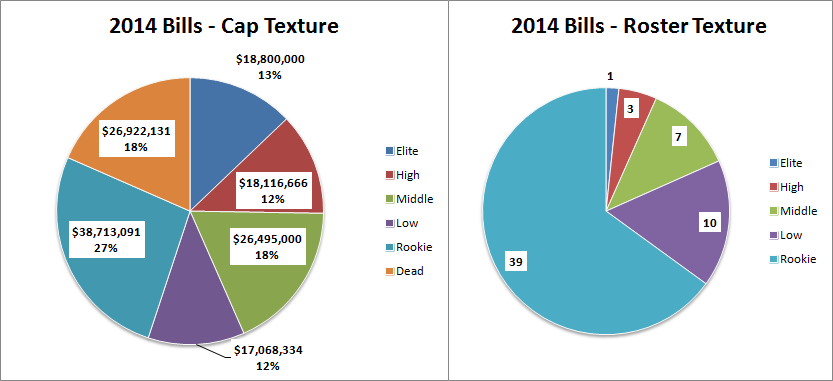
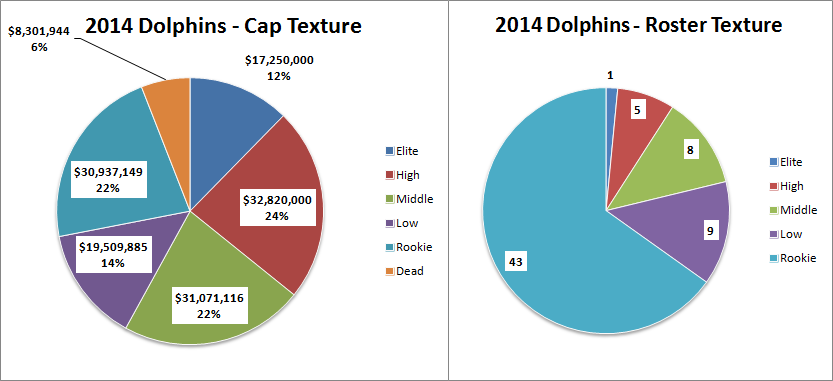
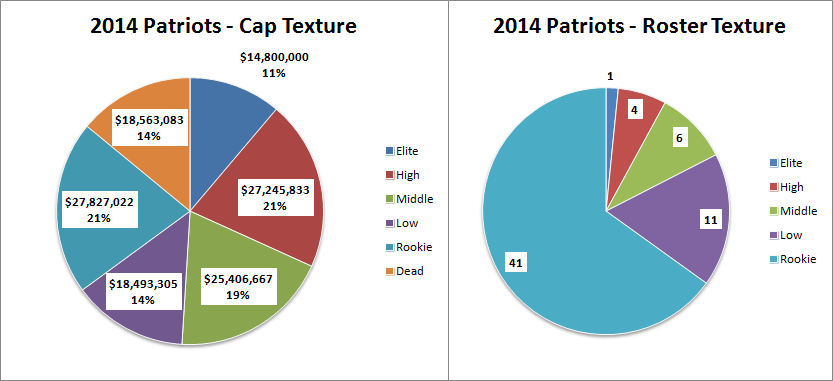
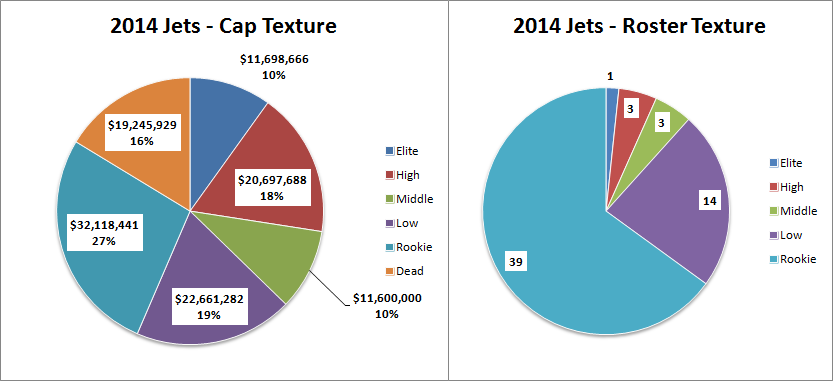
- As their pie chart for cap texture visually demonstrates, the Patriots were very well balanced among the six categories identified, having the 3rd-smallest standard deviation in that regard. Surely the friendly structure of their only Elite cap number in Tom Brady helps that a bit. A much larger sample size would be needed to see if such a balance is held in common with other Super Bowl champions.
- The Dolphins had the 4th highest proportion of spending on Elite/High/Middle veteran contracts at 58%. This is owed much to the recent spending sprees of the team in free agency. Unfortunately, unlike other teams with such a high percentage, like the Broncos or Packers, those expenditures did not translate into as much success on the field.
- In stark contrast to the Dolphins in this category were the Jets, who had the 2nd lowest proportion spent in the Elite/High/Middle veteran classes. But that strategy resulted in even less success for the Jets in 2014.
- The Bills had the 2nd highest amount of dead money in 2014, owed much to the ill-fated deals of players like Ryan Fitzpatrick and Stevie Johnson. One possible consequence may have been the need to skimp on lucrative veteran contracts, as the Bills ranked 28th in percentage of the cap devoted to Elite/High/Middle contracts.
AFC North
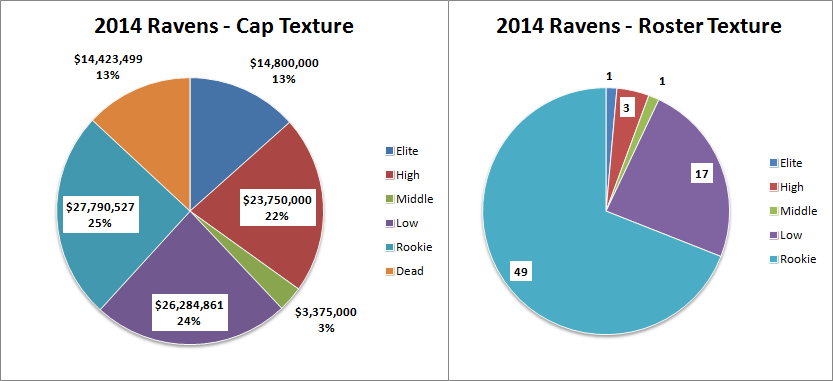
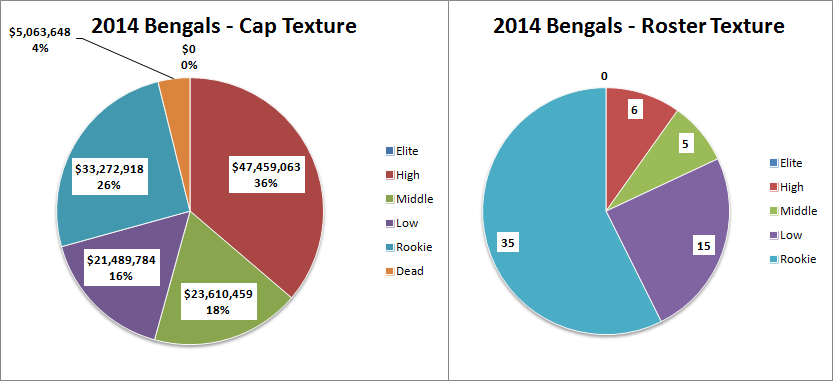
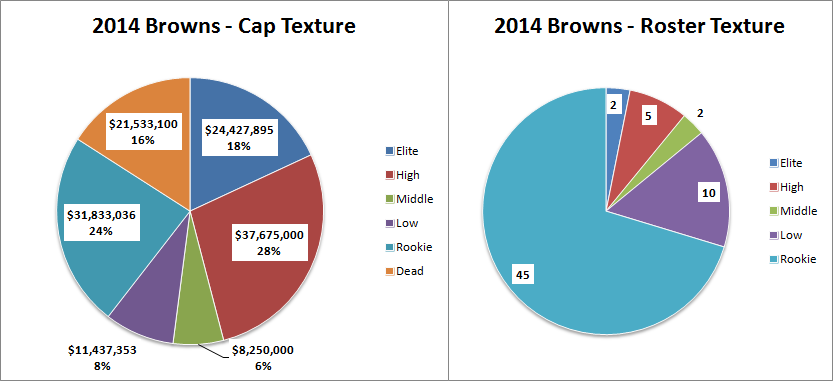
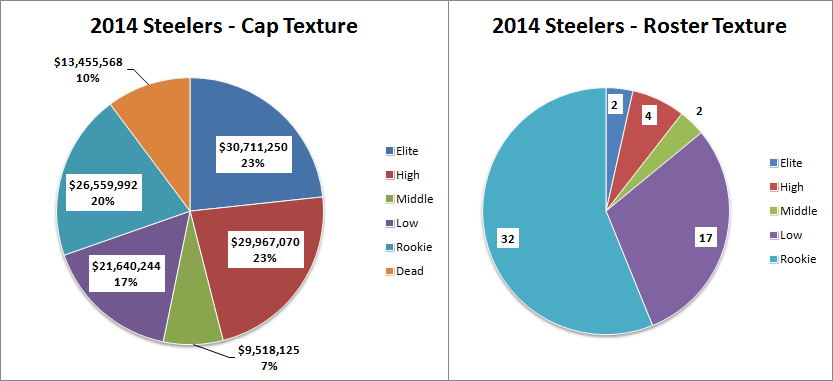
- No team had fewer players with Elite/High/Middle cap numbers than the Ravens with 5. If you’re familiar with Ozzie Newsome’s strategy as a GM, you shouldn’t be surprised by this. He is well known for letting players walk in free agency, take the compensatory picks that come with it, and replenish talent through the draft. This is also evident in the fact that the Ravens were tied with the Jaguars for most players employed on Rookie contracts.
- Meanwhile, it will be interesting to see if the new regime in Cleveland follows the Ravens’ way. They also had a high number of Rookie cap figures at 45, and although their cap numbers on the Elite/High/Middle veterans were average in 2014, for 2015 they let many free agents walk and should be awarded with numerous compensatory picks as a result.
- Although the quarterback premium is coming soon for the Bengals with Andy Dalton’s new contract, the lack of it allowed the team to devote a higher proportion of the cap to High and Middle veteran contracts, 3rd highest in the league.
- The Steelers weren’t on the young side in 2014, employing only 32 players on Rookie contracts. With the recent departures of players like Troy Polamalu and Ike Taylor, I would expect the Steelers’ texture to start changing soon.
AFC South
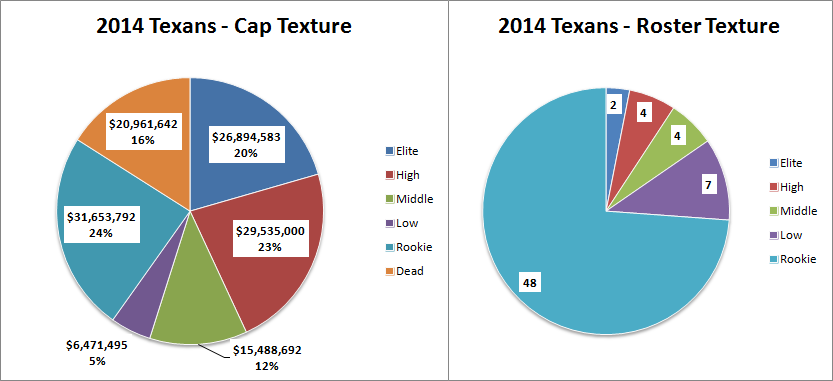
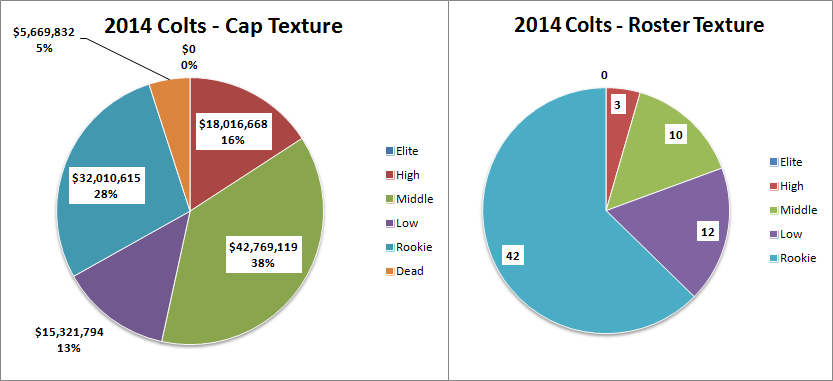
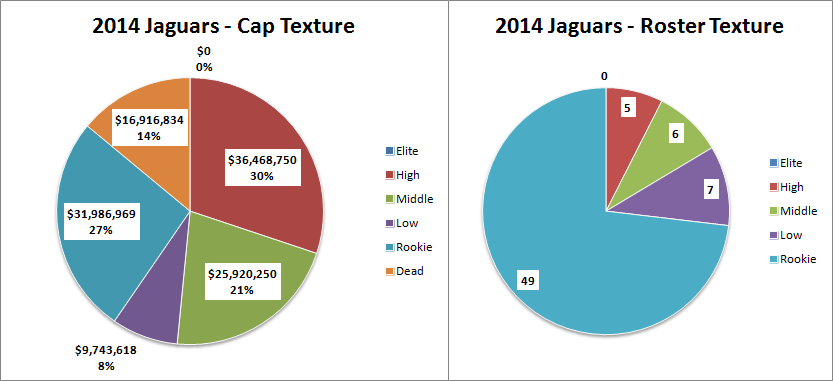
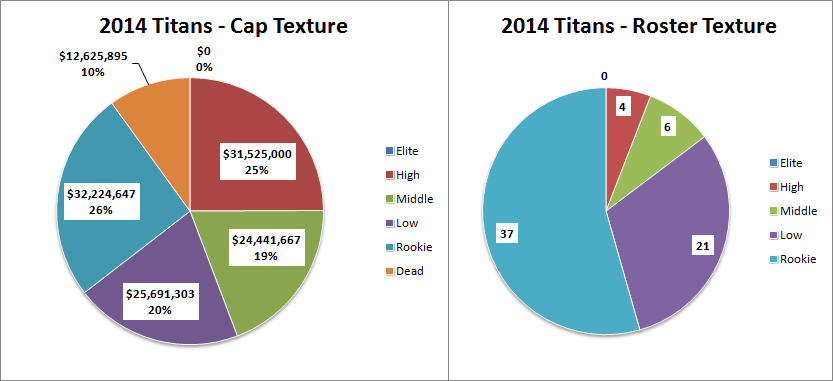
- Is there really any doubt that the Colts have landed a bargain with Andrew Luck? Having him still on his rookie deal has allowed the team to splurge on veteran contracts with Middle valued cap values. Among the Middle veteran class, the Colts had the highest proportion of the cap at 38%, and the second highest only to the Raiders in number (10) and total cap dollars (almost $43 million).
- The Jaguars’ texture makes it clear that they are building a young team, as they were tied for the lead in most Rookie contracts signed, and are tied for last with the fewest Low veteran cap numbers. Although they did make some large 2015 free agency expenditures, I would expect this general trend to continue a while for this team.
- The Texans were very much like their division rival Jaguars in 2014, keeping the Rookie cap numbers high at 48 and the Low veteran cap numbers low at 7. The only difference is that they had more players in house worthy of higher valued deals. Andre Johnson and Johnathan Joseph led the way with Elite cap numbers, and while Johnson is no longer with the team, JJ Watt will replace him in the Elite class come 2015.
- In their hopes of keeping the roster afloat, the Titans went heavy on Low valued veteran contracts in 2014 with 21. The end result wasn’t good, as the team finished the year tied for the worst record in the league.
AFC West
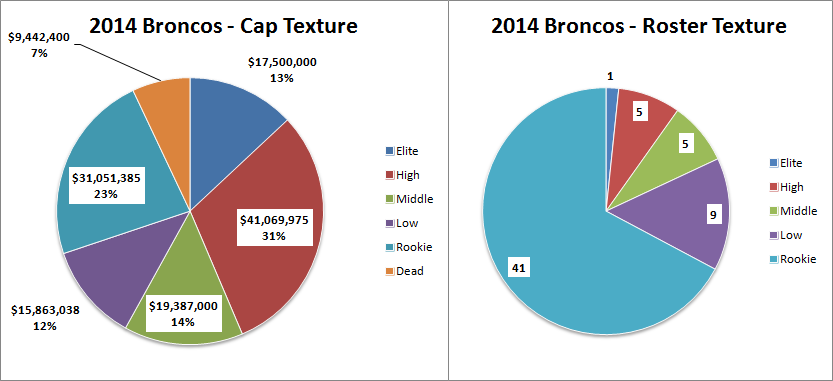
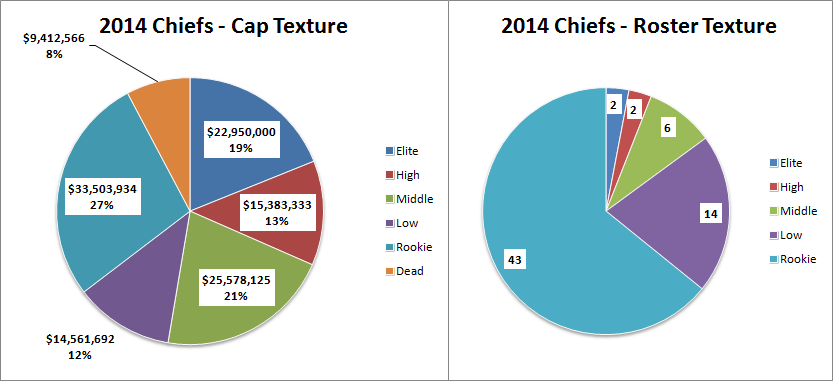
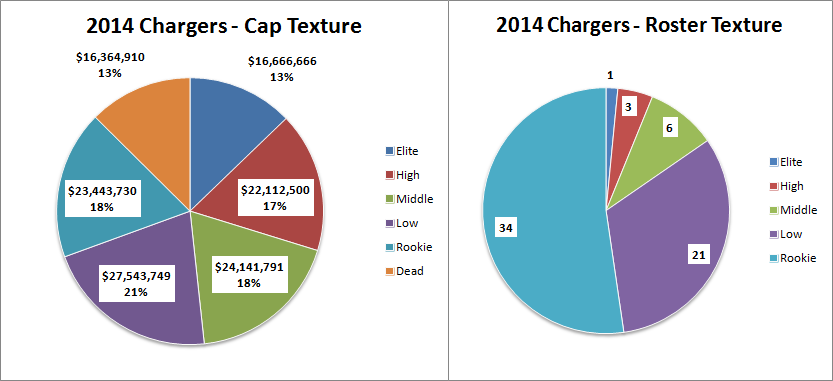
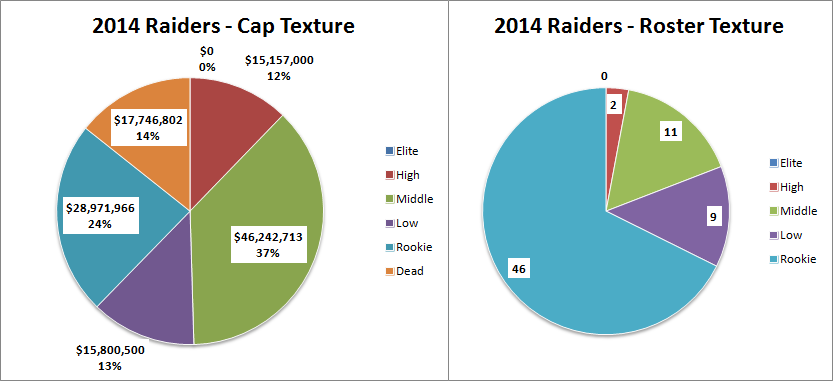
- The Broncos have had a recent habit of letting several starters from their Rookie contracts walk in free agency, and collecting the compensatory draft picks that come with it. One reason is that there’s only so many players they could re-sign: Denver was on the high end of both the number (11) and percentage (58%–3rd highest in the league) of cap numbers devoted to the Elite/High/Middle range.
- The Chiefs were able to avoid the quarterback premium in 2014, though that should change in 2015 as Alex Smith’s compensation will go up. Unfortunately, one of their two Elite cap numbers in 2014 was sunk on Dwayne Bowe, who had a cap number of over $11 million in exchange for famously failing to score any touchdowns. It’s safe to say that cutting Bowe was one of the most obvious decisions the Chiefs could do for 2015.
- Do you want more proof that Reggie McKenzie has purged the last vestiges of how Al Davis ran the Raiders? The Raiders had a league-low 2 veterans in the combined Elite and High classes. Those two players, by the way, were Matt Schaub and Tyvon Branch, neither of whom are on the Raiders in 2015. They made up for this by leading the league in Middle veteran cap numbers at 11, and were also tied for the 4th highest number of Rookie contracts employed, at 46.
- The Chargers were another team that had few Rookies (34) and many Low veterans (21). Combine this with the fact that two of their spendier contracts (Philip Rivers and Eric Weddle) are ending soon, and beyond 2015 this is a team that might look drastically different than we are accustomed to.
NFC East
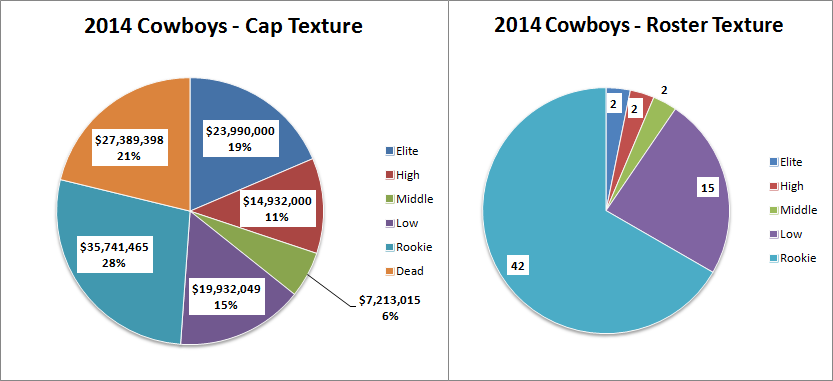
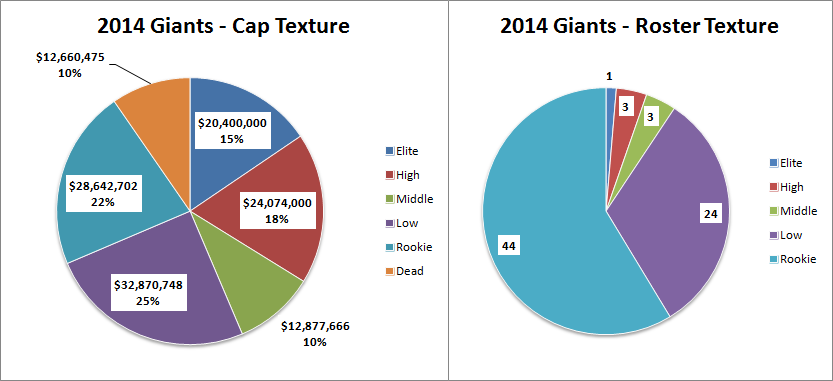
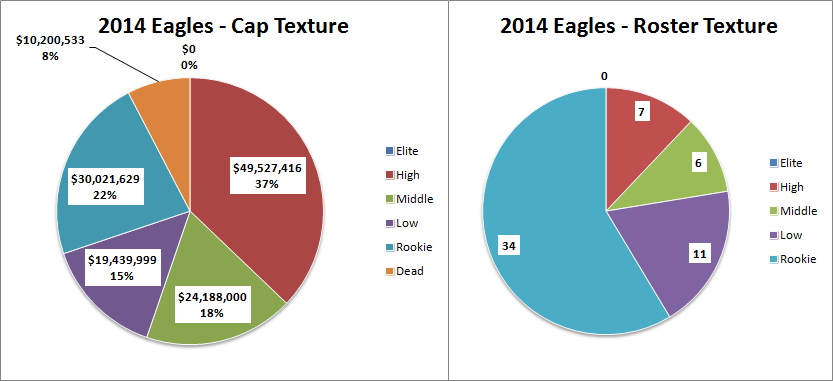
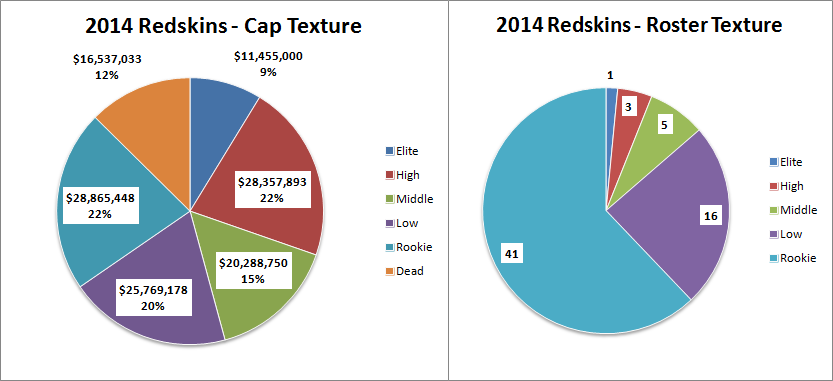
- The 2014 Cowboys are a fascinating team of texture contrast. They led the league in dead money at over $27 million, eating up 21% of their cap. The consequence of that is that they had the league-fewest number of players with Elite/High/Middle cap numbers at 6, and relied on Rookie contracts for 28% of their cap. But when you consider that the Cowboys made it to the divisional round of the playoffs and have some good, young talent in those Rookie contracts, it shows reason for optimism in Dallas.
- The Eagles were another team that did not have to deal with the quarterback premium or other Elite valued cap numbers, and that allowed them to employ en masse with 13 veterans on High or Middle valued cap numbers.
- The Eagles and Giants provide the extreme examples on how the numbers of players on Low veteran contracts and Rookie contracts need to be taken with a grain of salt. The Eagles were the second healthiest team in 2014 with only 6 players landing on IR, while the Giants were the most injured with 22. For this reason, the Giants had to employ far more Low veterans and Rookies (68) than the Eagles (45).
- The Redskins employed a slightly above average number of Low veterans in 2014 at 16. But the cap space those players took was considerably higher at 20%–and it took away from the cap amounts devoted to Elite/High/Middle players, ranking 25th in the league at 45.8%. However, with few players obviously deserving a raise on the roster, it’s a texture that might be justified for where the Redskins were at that year.
NFC North
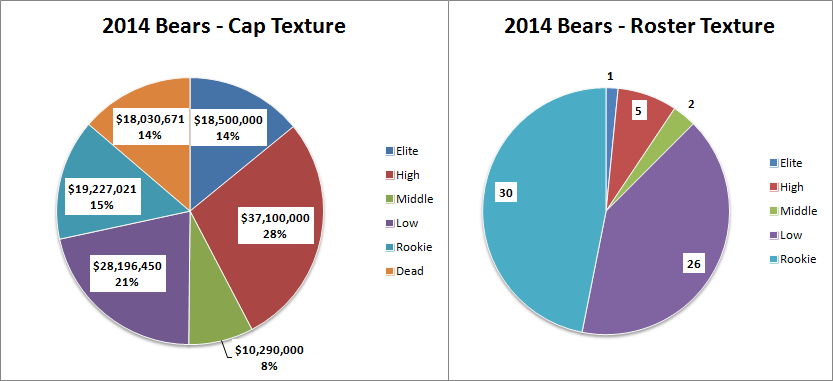

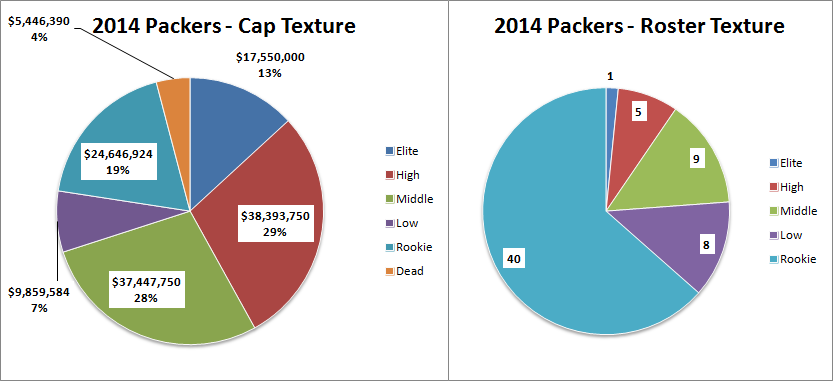
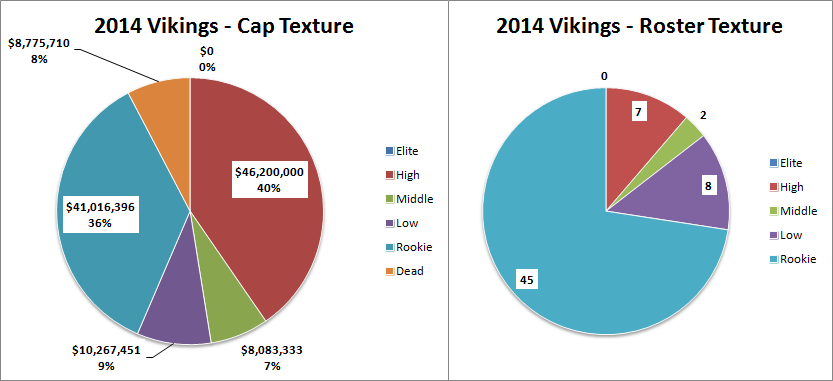
- The Packers led the league in both the number of veterans in the Elite/High/Middle range with 15, and also led the league with the highest percentage of the cap devoted to those players in 70%. How did they do it? Having the second-lowest dead money percentage at 4.1% helps a lot, of course. But what’s even better for the Packers is that they haven’t had to skimp on rookies to pull off those numbers—they had a perfectly average number of them with 40. This reflects very well on Ted Thompson’s philosophy of relying on good drafting and then rewarding homegrown talent when they’ve earned it.
- No team had a fewer number of players on Rookie contracts than the Bears at 30. This is partly because they were the second healthiest team in 2014 (only 13 players on IR). But health does not explain at all the fact that they had the league-highest number of Low veteran cap numbers (26). Considering that the Bears went 6-10 last year, it can’t be too promising of a sign that the team did not have enough reliable homegrown talent to build upon.
- The Lions were the only team to have 3 veteran with Elite cap numbers. The notorious consequence of that, of course, was that those three players (Matt Stafford, Calvin Johnson, and Ndamukong Suh) soaked up 40% of the entire salary cap. As a result, the Lions were unable to retain any veterans in the High class, and only 4 veterans in the Middle class. Their Elite/High/Middle tally of 7 was tied for the second lowest in the league. As a result, the Lions were overly reliant on veterans with Low veteran cap numbers, fifth most in the league with 20. They also had the third fewest number of Rookie contracts on their team with 33. At least the good news for the Lions is that they made the playoffs with that very top-heavy and veteran-heavy roster. Now that Suh is off the books, I would anticipate that the Lions’ 2015 texture will look much different.
- No team spent more on players with Rookie contracts than the Vikings, taking up 36% of their cap. This can be attributed to their recent habit of trading up to acquire multiple first round picks in several drafts. But since this is a team that did not have any Elite valued veteran cap numbers, and will aim to avoid the quarterback premium with Teddy Bridgewater for several seasons, it’s a trend that could pay dividends for the team if they end up hitting on their higher draft picks.
NFC South
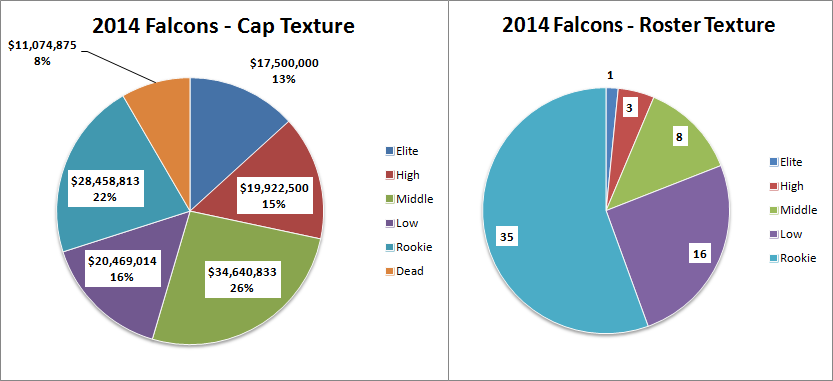
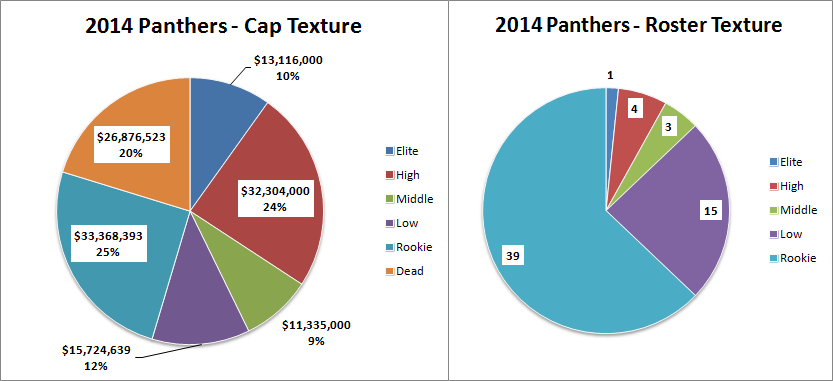
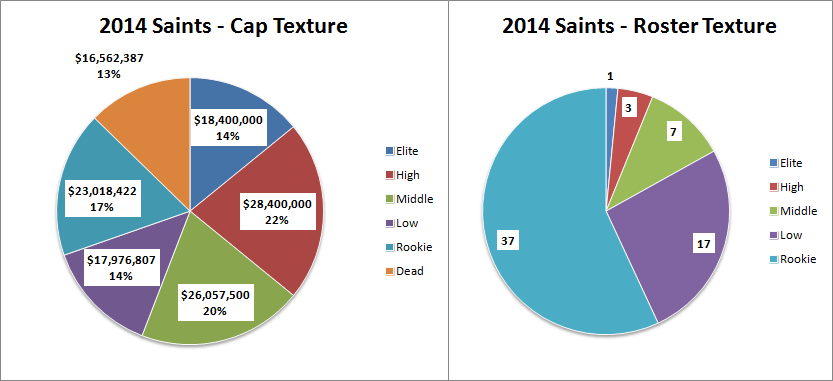
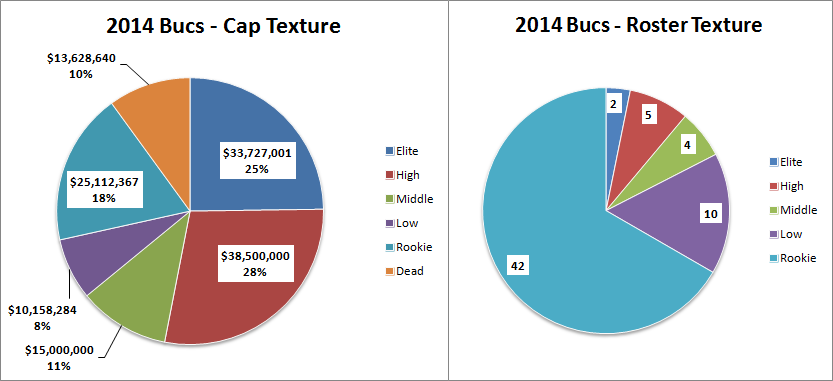
- The Panthers had one of the highest dead money amounts in 2014, as they were still atoning for the sins of the Marty Hurney regime. Despite this and a 7-9 record, they still won a playoff game, and with the dead money likely to be less in 2015, and with the only Elite cap number in Greg Hardy to be replaced with Cam Newton, things have to look a bit more positive for their outlook.
- The Buccaneers were second to the Packers in proportion of the cap spent on Elite/High/Middle veteran contracts, at 64.1%. But in very stark contrast to the Packers, all that spending earned them the worst record in 2014, and several of those players under those contracts, like Michael Johnson, Anthony Collins, and Dashon Goldson, were disposed of in the 2015 offseason.
- The Saints are well known for spending well, and their high proportion of Elite/High/Middle cap figures at 56% demonstrates it. The downside is that it’s earned themselves some cap room woes, and with some major changes in the 2015 offseason, their texture may change as a result.
- The Falcons were middle-heavy in 2014, devoting the fourth highest proportion of the cap to Middle contracts at 26%. It reflects a team that’s a bit in flux, a team with some stalwarts like Matt Ryan and Roddy White still in employ, some cheaper rookies and veterans in place, but at the same time trying to patch the remaining holes with solutions in between.
NFC West
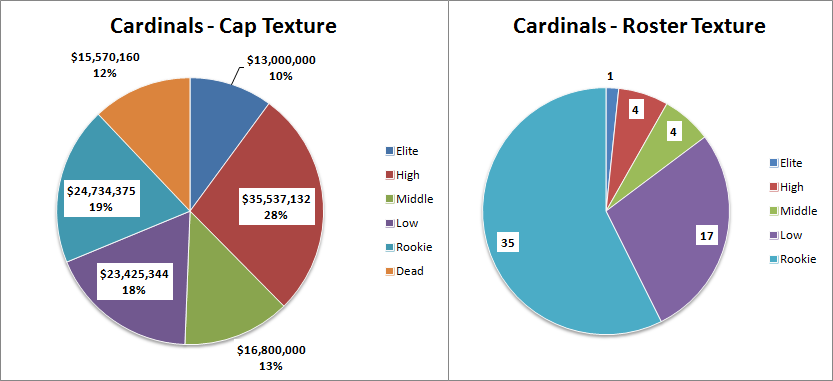
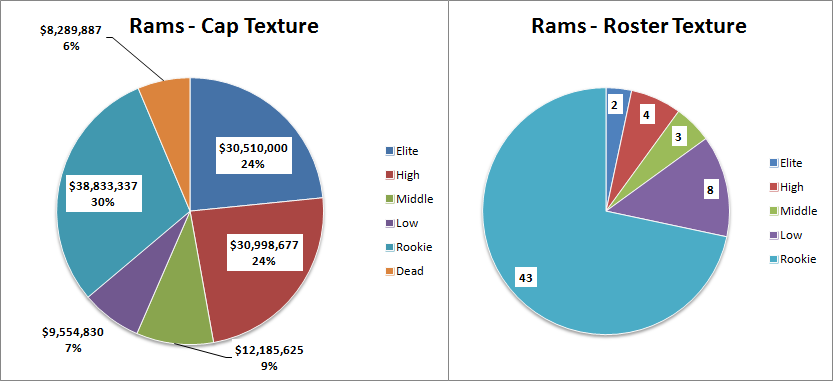
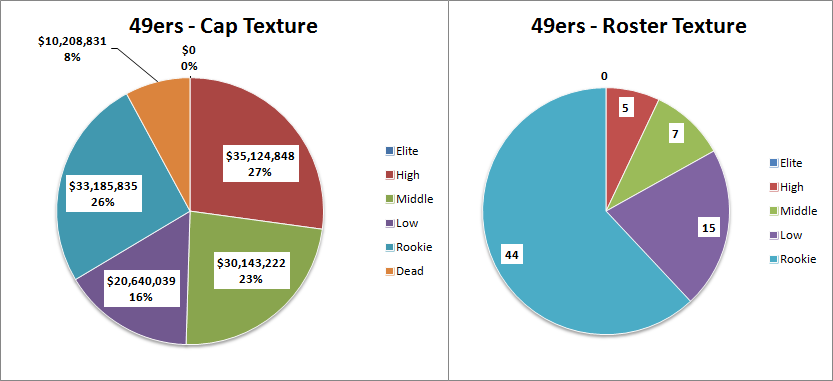
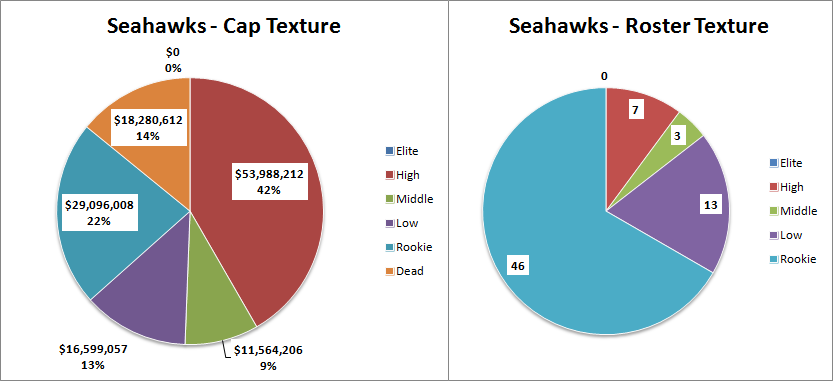
- Is there any team more grateful to have such a cheap yet valuable quarterback contract on the roster than the Seahawks? Avoiding the quarterback premium with Russell Wilson has allowed Seattle to go into overdrive on contracts sustaining High cap numbers, the league leader both in number (7), cap proportion (42%), and total value ($54 million). And yet they still have an eye on the future with 46 Rookie cap figures on the books for 2014.
- The 49ers also avoided the quarterback premium, but 2014 was the last season as Colin Kaepernick will incur that premium come 2015. As you’d expect, like the Seahawks the 49ers took advantage of that by devoting half of their cap to veteran contracts with High or Middle numbers.
- The Rams are both top-heavy and heavy on youth. They had the 2nd highest spending on contracts with Elite and High cap figures at over $60 million. Yet they still backed that up with an above average number of Rookie cap figures on the books with 43, owed greatly to the Robert Griffin III trade for sure.
- The Cardinals were fairly well balanced in the six classifications in 2014, with their High cap numbers taking up the most space. The question will be if their roster changes for 2015 shake up the texture, such as losing Darnell Dockett, adding Mike Iupati, extending Carson Palmer, and seeing Jared Veldheer’s cap number increase.